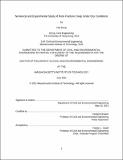Numerical and Experimental Study of Rock Fracture Creep Under Dry Conditions
Author(s)
Kang, Hao
DownloadThesis PDF (13.16Mb)
Advisor
Einstein, Herbert
Terms of use
Metadata
Show full item recordAbstract
In many rock engineering projects such as hydrocarbon extraction or geothermal energy utilization, the hydro-mechanical behavior of rock fractures has a strong effect on the safety and profitability of the project. In field conditions, the hydraulic and mechanical behavior of rock fractures changes with time (the rock fractures creep). Rock fracture creep is a coupled process of four mechanisms: mechanical compression, pressure solution, dissolution, and erosion. To obtain systematic results, it is important to consider these mechanisms separately. Previous research indicates that rock fracture creep under dry conditions is not negligible, and under dry conditions, mechanical compression is the only mechanism.
Experimental work has been conducted to investigate the size and time dependency of the creep of Musandam limestone (a reservoir rock). The elastic and strength properties of Musandam limestone were obtained from triaxial and indentation tests. The results indicate that linear elasticity and von Mises plasticity can reasonably well describe the contacting asperity deformation. Then, triaxial, micro- and nano-indentation creep tests were conducted, and their creep patterns were compared. The results imply that the creep patterns of triaxial and indentation tests are different. In addition, micro- and nano-indentation test results show a time-hardening and a time-softening behavior, respectively. The experimental results can provide a reference for rock creep measurements and modeling.
To study the effect of surface geometry on fracture dry creep, initial steps considering viscoelasticity have been taken. A numerical model was developed to investigate the effect of surface geometry on rock fracture visco-elastic deformation. First, synthetic fracture surfaces were generated based on Brown’s (1995) model: the Hurst exponent, root mean square roughness, and mismatch length were varied systematically. Then, an in-house numerical code was developed to simulate the visco-elastic deformation of rough fractures. The results indicate that by increasing the Hurst exponent or decreasing the mismatch length or decreasing the root mean square roughness, the fracture mean aperture decreases, and the contact ratio (the number of contacting cells / total number of cells) increases faster with time. The numerical results can be used to predict visco-elastic deformation of rough rock fractures.
Date issued
2021-06Department
Massachusetts Institute of Technology. Department of Civil and Environmental EngineeringPublisher
Massachusetts Institute of Technology